Discover 35 hidden attractions, cool sights, and unusual things to do in Barcelona (Spain). Don't miss out on these must-see attractions: Sagrada Família, Park Güell, and Casa Milà. Also, be sure to include Casa Batlló in your itinerary.
Below, you can find the list of the most amazing places you should visit in Barcelona (Catalonia).
Table of Contents
Sagrada Família
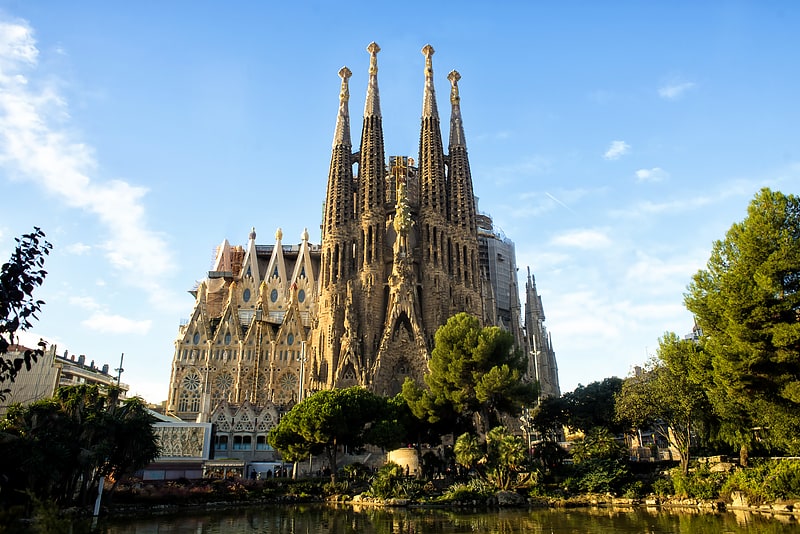
Also known as: Templo Expiatorio de la Sagrada Familia
Gaudí-designed landmark church. The Basílica i Temple Expiatori de la Sagrada Família, also known as the Sagrada Família, is a large unfinished minor basilica in the Eixample district of Barcelona, Catalonia, Spain. Designed by the Catalan architect Antoni Gaudí, his work on the building is part of a UNESCO World Heritage Site. On 7 November 2010, Pope Benedict XVI consecrated the church and proclaimed it a minor basilica.
On 19 March 1882, construction of the Sagrada Família began under architect Francisco de Paula del Villar. In 1883, when Villar resigned, Gaudí took over as chief architect, transforming the project with his architectural and engineering style, combining Gothic and curvilinear Art Nouveau forms. Gaudí devoted the remainder of his life to the project, and he is buried in the crypt. At the time of his death in 1926, less than a quarter of the project was complete.
Relying solely on private donations, the Sagrada Família's construction progressed slowly and was interrupted by the Spanish Civil War. In July 1936, revolutionaries set fire to the crypt and broke their way into the workshop, partially destroying Gaudí's original plans, drawings and plaster models, which led to 16 years of work to piece together the fragments of the master model. Construction resumed to intermittent progress in the 1950s. Advancements in technologies such as computer aided design and computerised numerical control (CNC) have since enabled faster progress and construction passed the midpoint in 2010. However, some of the project's greatest challenges remain, including the construction of ten more spires, each symbolising an important Biblical figure in the New Testament. It was anticipated that the building would be completed by 2026, the centenary of Gaudí's death, but this has now been delayed due to the COVID-19 pandemic.
The basilica has a long history of splitting opinion among the residents of Barcelona: over the initial possibility it might compete with Barcelona's cathedral, over Gaudí's design itself, over the possibility that work after Gaudí's death disregarded his design, and the 2007 proposal to build a tunnel nearby as part of Spain's high-speed rail link to France, possibly disturbing its stability. Describing the Sagrada Família, art critic Rainer Zerbst said "it is probably impossible to find a church building anything like it in the entire history of art", and Paul Goldberger describes it as "the most extraordinary personal interpretation of Gothic architecture since the Middle Ages". The basilica is not the cathedral church of the Archdiocese of Barcelona, as that title belongs to the Cathedral of the Holy Cross and Saint Eulalia.[1]
Address: Carrer de Mallorca, 401, 08013 Barcelona (Eixample)
Park Güell
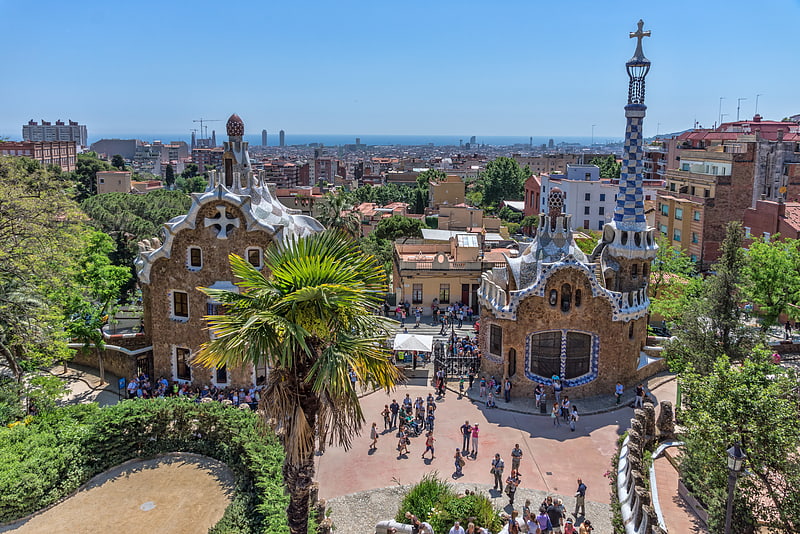
Also known as: Parque Güell
Park with Gaudi's sculptural buildings. Parc Güell is a privatized park system composed of gardens and architectural elements located on Carmel Hill, in Barcelona, Catalonia, Spain. Carmel Hill belongs to the mountain range of Collserola – the Parc del Carmel is located on the northern face. Park Güell is located in La Salut, a neighborhood in the Gràcia district of Barcelona. With urbanization in mind, Eusebi Güell assigned the design of the park to Antoni Gaudí, a renowned architect and the face of Catalan modernism.
The park was built from 1900 to 1914 and was officially opened as a public park in 1926. In 1984, UNESCO declared the park a World Heritage Site under "Works of Antoni Gaudí".[2]
Address: Carrer d'Olot, 5, 08024 Barcelona (Gràcia)
Casa Milà
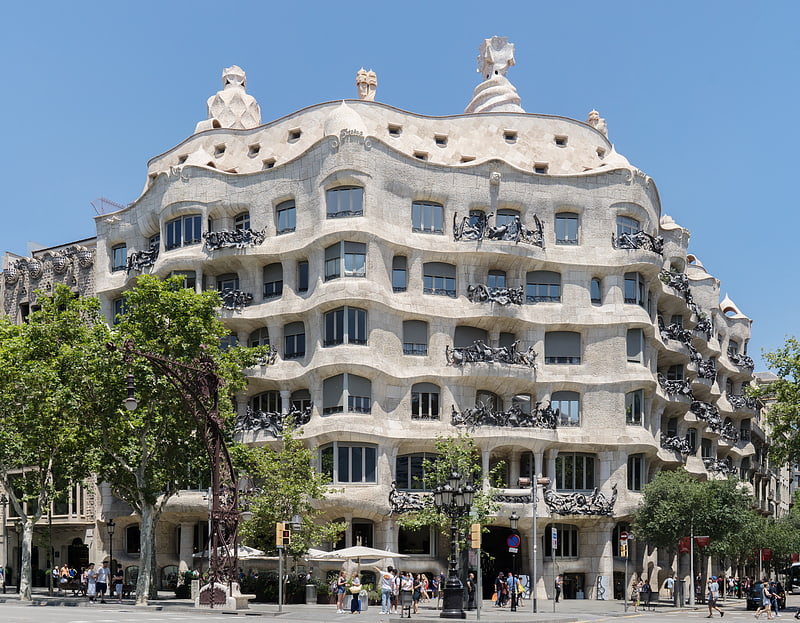
Gaudi masterpiece housing arts venue. Casa Milà, popularly known as La Pedrera or "The stone quarry", a reference to its unconventional rough-hewn appearance, is a Modernista building in Barcelona, Catalonia, Spain. It was the last private residence designed by architect Antoni Gaudí and was built between 1906 and 1912.
The building was commissioned in 1906 by Pere Milà and his wife Roser Segimon. At the time, it was controversial because of its undulating stone facade, twisting wrought iron balconies and designed by Josep Maria Jujol. Several structural innovations include a self-supporting stone façade, and a free-plan floor, underground garage and the spectacular terrace on the roof.
In 1984, it was declared a World Heritage Site by UNESCO. Since 2013 it has been the headquarters of the Fundació Catalunya La Pedrera which manages the visit to the building, exhibitions and other cultural and educative activities at Casa Milà.[3]
Address: Barcelona, 92, Passeig de Gràcia
Casa Batlló
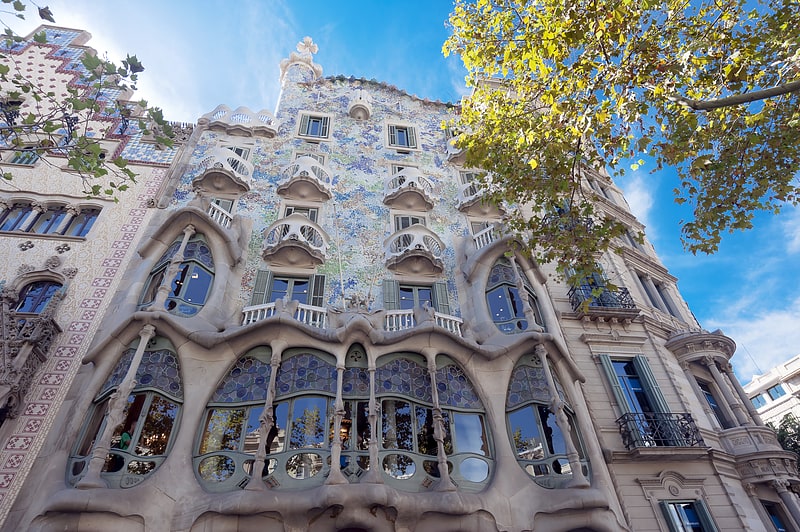
Fantastical Gaudi-designed apartments. Casa Batlló is a building in the center of Barcelona. It was designed by Antoni Gaudí, and is considered one of his masterpieces. A remodel of a previously built house, it was redesigned in 1904 by Gaudí and has been refurbished several times after that. Gaudí's assistants Domènec Sugrañes i Gras, Josep Canaleta and Joan Rubió also contributed to the renovation project.
The local name for the building is Casa dels ossos (House of Bones), as it has a visceral, skeletal organic quality. It is located on the Passeig de Gràcia in the Eixample district, and forms part of a row of houses known as the Illa de la Discòrdia (or Mansana de la Discòrdia, the "Block of Discord"), which consists of four buildings by noted Modernista architects of Barcelona.
Like everything Gaudí designed, Casa Batlló is only identifiable as Modernisme or Art Nouveau in the broadest sense. The ground floor, in particular, has unusual tracery, irregular oval windows and flowing sculpted stone work. There are few straight lines, and much of the façade is decorated with a colorful mosaic made of broken ceramic tiles (trencadís). The roof is arched and was likened to the back of a dragon or dinosaur. A common theory about the building is that the rounded feature to the left of centre, terminating at the top in a turret and cross, represents the lance of Saint George (patron saint of Catalonia, Gaudí's home), which has been plunged into the back of the dragon.
In 2005, Casa Batlló became an UNESCO World Heritage Site among the other Works of Antoni Gaudí, and is visited by people from around the world.[4]
Address: Passeig de Gràcia, 43, 08007 Barcelona (Eixample)
Palau de la Música Catalana

Also known as: Palacio de la Música Catalana
Music recitals in bold art nouveau hall. Palau de la Música Catalana is a concert hall in Barcelona, Catalonia, Spain. Designed in the Catalan modernista style by the architect Lluís Domènech i Montaner, it was built between 1905 and 1908 for Orfeó Català, a choral society founded in 1891 that was a leading force in the Catalan cultural movement that came to be known as the Renaixença. It was inaugurated on 9 February 1908.
The construction project was mainly financed by Orfeó Català, but important financial contributions also came from Barcelona's wealthy industrialists and bourgeoisie. The palace won the architect an award from the Barcelona City Council in 1909, given to the best building built during the previous year. Between 1982 and 1989, the building underwent extensive restoration, remodeling, and extension under the direction of architects Oscar Tusquets and Carles Díaz. In 1997, the palace de la Música Catalana was declared a UNESCO World Heritage Site along with Hospital de Sant Pau. Today, more than half a million people a year attend musical performances in the Palau that range from symphonic and chamber music to jazz and Cançó (Catalan song).[5]
Address: C/ Palau de la Música, 4-6, 08003 Barcelona (Ciutat Vella)
Picasso Museum

Also known as: Museo Picasso de Barcelona
Museum in Barcelona, Spain. The Museu Picasso, located in Barcelona, Catalonia, Spain, houses one of the most extensive collections of artworks by the 20th-century Spanish artist Pablo Picasso. With 4,251 works exhibited by the painter, the museum has one of the most complete permanent collections of works. The museum is housed in five adjoining medieval palaces in Barcelona's La Ribera neighborhood, in the Old City, and more specifically, it is located on Montcada Street, a formerly very prestigious street home to wealthy merchants and nobility from the Gothic to the Baroque periods. It opened to the public on 9 March 1963, becoming the first museum dedicated to Picasso's work and the only one created during the artist's lifetime. It has since been declared a museum of national interest by the Government of Catalonia.
Highlights of the collection include two of his first major works, The First Communion (1896), and Science and Charity (1897). In particular, the Museu Picasso reveals Picasso's relationship with the city of Barcelona, a relationship that was shaped in his youth and adolescence and continued until his death.[6]
Address: Carrer Montcada, 15-23, 08003 Barcelona (Ciutat Vella)
La Boqueria
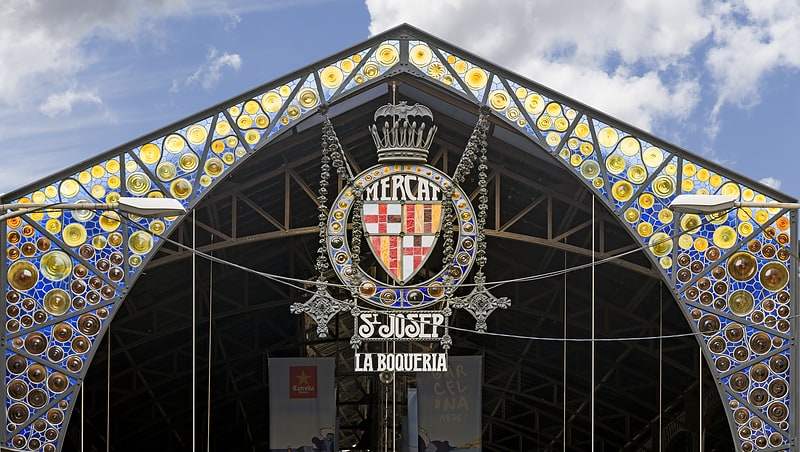
Also known as: La Boquería
Vibrant public market with diverse foods. The Mercat de Sant Josep de la Boqueria, often simply referred to as La Boqueria, is a large public market in the Ciutat Vella district of Barcelona, Catalonia, Spain, and one of the city's foremost tourist landmarks, with an entrance from La Rambla, not far from the Liceu, Barcelona's opera house. The market has a very diverse selection of goods.[7]
Address: La Rambla, 91, 08001 Barcelona (Ciutat Vella)
Museu Nacional d'Art de Catalunya
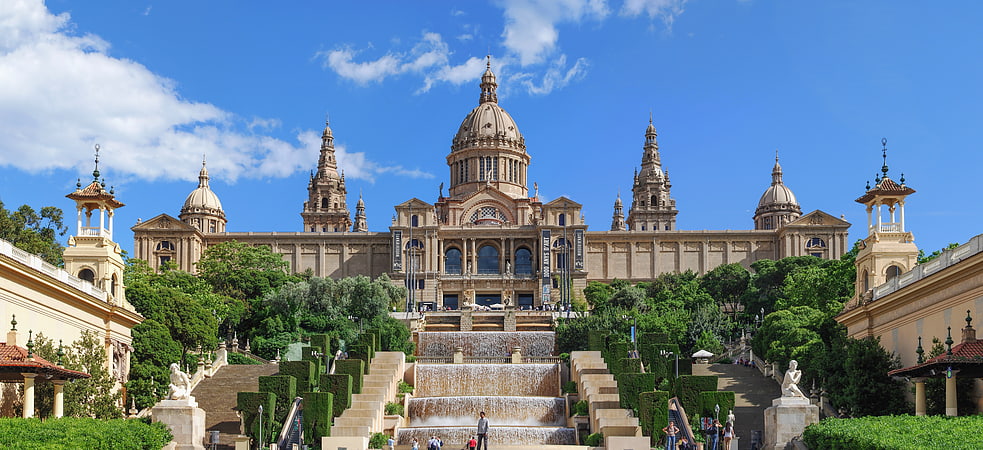
Also known as: Museo Nacional de Arte de Cataluña
11th- to 20th-century Catalan art museum. The Museu Nacional d'Art de Catalunya, abbreviated as MNAC, is a museum of Catalan visual art located in Barcelona, Catalonia, Spain. Situated on Montjuïc hill at the end of Avinguda de la Reina Maria Cristina, near Pl Espanya, the museum is especially notable for its outstanding collection of romanesque church paintings, and for Catalan art and design from the late 19th and early 20th centuries, including modernisme and noucentisme. The museum is housed in the Palau Nacional, a huge, Italian-style building dating to 1929. The Palau Nacional, which has housed the Museu d'Art de Catalunya since 1934, was declared a national museum in 1990 under the Museums Law passed by the Catalan Government. That same year, a thorough renovation process was launched to refurbish the site, based on plans drawn up by the architects Gae Aulenti and Enric Steegmann, who were later joined in the undertaking by Josep Benedito. The Oval Hall was reopened in 1992 on the occasion of the Olympic Games, and the various collections were installed and opened over the period from 1995 to 2004. The Museu Nacional d'Art de Catalunya was officially inaugurated on 16 December 2004. It is one of the largest museums in Spain.[8]
Address: Parc de Montjuïc, s/n, 08038 Barcelona (Sants-Montjuïg)
CosmoCaixa
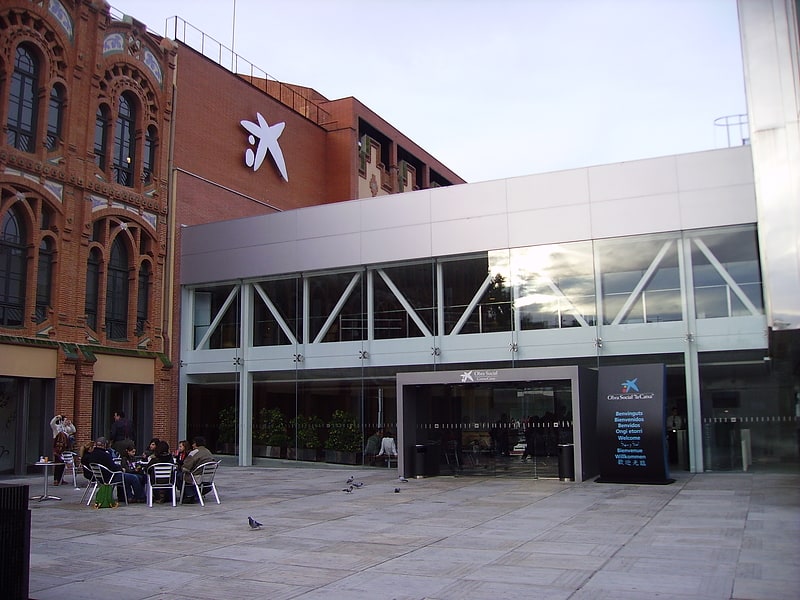
Science museum in Modernist building. CosmoCaixa Barcelona is a science museum located in Barcelona, Catalonia, Spain. Formerly known as the Science Museum of Barcelona, it closed for renovations in 1998 and reopened in 2004 under its current name. The museum features a variety of exhibitions, permanent and temporary, that showcase the environment, nature, science, and space. CosmoCaixa also has a planetarium and exhibitions devoted to interaction such as touch and play for small children. It also has a bookstore, gift shop, library, teaching center and cafe. The museum is sponsored by la Caixa. Entry to the museum is free for students under 16. Adults too can enjoy at the museum with an entry ticket of 6 euros.[9]
Address: Carrer d'Isaac Newton, 26, 08022 Barcelona (Sarrià-Sant Gervasi)
El Raval
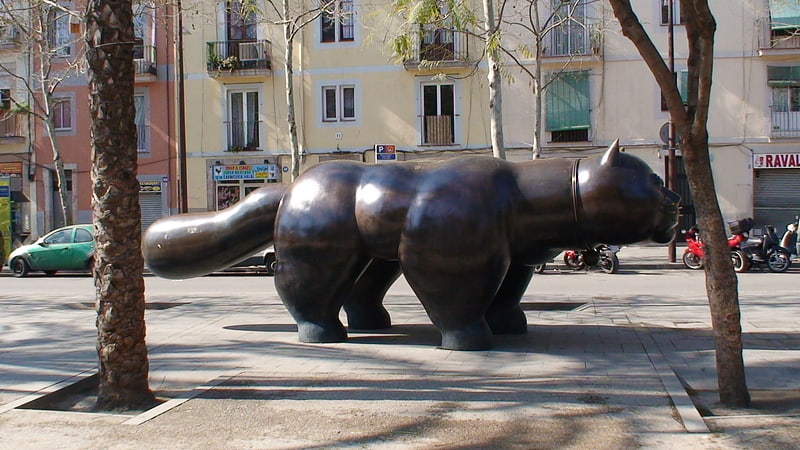
Neighborhood in Barcelona, Spain. El Raval is a neighborhood in the Ciutat Vella district of Barcelona, the capital city of Catalonia. The neighborhood, especially the part closest to the old port, was formerly known as Barri Xinès or Barrio Chino, meaning "Chinatown". El Raval is one of the two historical neighborhoods that border La Rambla, the other being the Barri Gòtic; it contains some 50,000 people.
An area historically infamous for its nightlife and cabarets, as well as prostitution and crime, El Raval has changed significantly in recent years and due to its central location has become a minor attraction of Barcelona. It currently has a very diverse immigrant community (47.4% of its population was born abroad, ranging from all South America, Pakistanis and Filipinos, to a more recent Eastern European community, especially from Romania). It is home to many bars, restaurants, and night spots.[10]
CaixaForum Barcelona
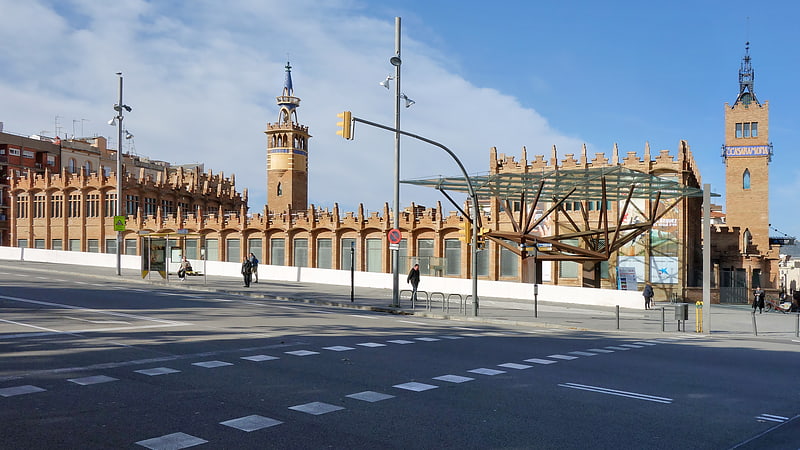
Contemporary arts center in old factory. CaixaForum Barcelona is an art gallery in Barcelona, Catalonia, Spain. It is sponsored by Barcelona bank "la Caixa", and opened in 2002 in a former factory. CaixaForum is located in the Montjuïc area, on Avinguda de Francesc Ferrer i Guàrdia. The museum houses art exhibits.[11]
Address: Av. Francesc Ferrer i Guàrdia, 6-8, 08038 Barcelona (Sants-Montjuïg)
Parc de la Ciutadella

Also known as: Parque de la Ciudadela
19th-century formal park with zoo. The Parc de la Ciutadella is a park on the northeastern edge of Ciutat Vella, Barcelona, Catalonia, Spain. For decades following its creation in the mid-19th century, this park was the city's only green space. The 70-acre grounds include the city zoo, the Palau del Parlament de Catalunya, a small lake, museums, and a large fountain designed by Josep Fontserè.
As the location of the Parliament of Catalonia, the tensions in 2018 and 2019 regarding Catalan independence regularly led to the police closure of the park to public access to prevent crowds forming near to the official buildings.[12]
Address: Passeig de Picasso, 21, 08003 Barcelona (Ciutat Vella)
Church of Colònia Güell
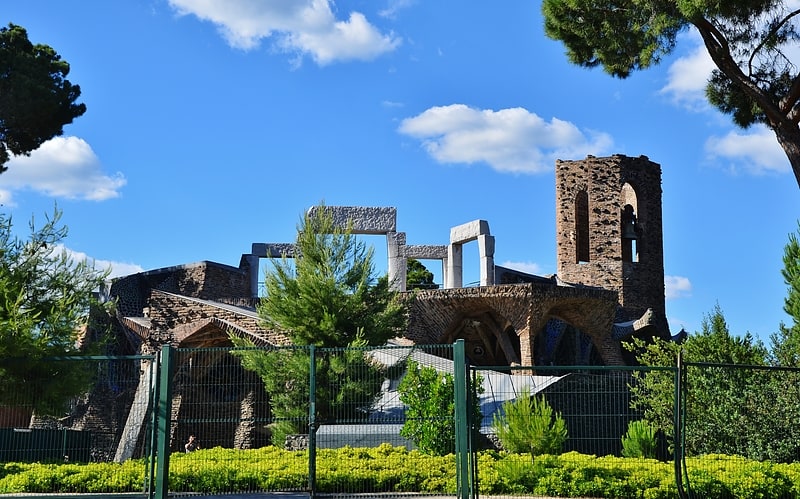
Also known as: Cripta de la Colonia Güell
Famed architect's grotto-like crypt. The Church of Colònia Güell is an unfinished work by Antoni Gaudí. It was built as a place of worship for the people on a hillside in a manufacturing suburb in Santa Coloma de Cervelló, near Barcelona. Colònia Güell was the brainchild of Count Eusebi de Güell; who enlisted the help of architect Antoni Gaudí in 1898. However, work was not started until 1908, 10 years after commission. The plan for the building consisted of constructing two naves, an upper and a lower, two towers, and one forty-meter-high central dome. In 1914, the Güell family halted construction due to the death of Count Güell. At the time, the lower nave was almost complete so between the years of 1915 and 1917, it was completed and readied for use.
The Church is one of the seven properties Gaudí built near Barcelona that are Unesco World Heritage Sites. Collectively, these sites are known as the Works of Antoni Gaudí, and show his, "exceptional creative contribution to the development of architecture and building technology in the late 19th and early 20th centuries."[13]
Address: Claudi Guell, 6, 08690 Santa Coloma de Cervello
Columbus Monument
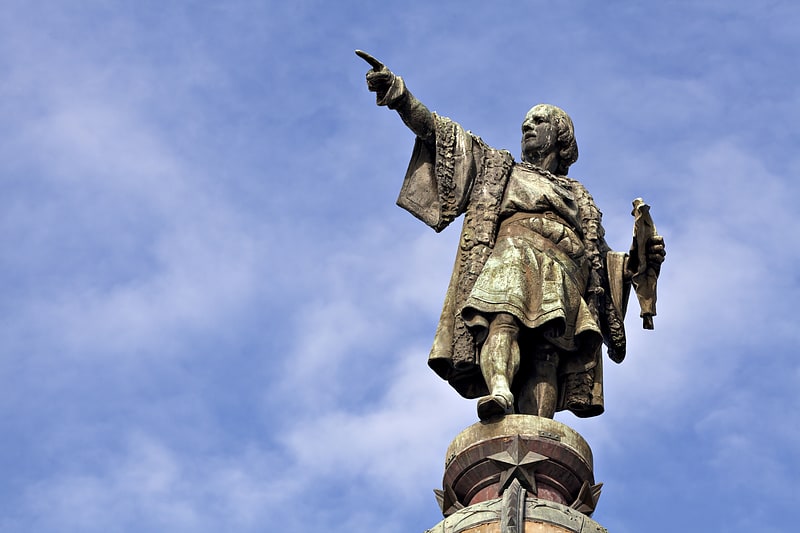
Also known as: Monumento a Colón
Towering seafront monument to Columbus. The Columbus Monument is a 60 m tall monument to Christopher Columbus at the lower end of La Rambla, Barcelona, Catalonia, Spain. It was constructed for the Exposición Universal de Barcelona in honor of Columbus' first voyage to the Americas. The monument serves as a reminder that Christopher Columbus reported to Queen Isabella I and King Ferdinand V in Barcelona after his first trip to the new continent.[14]
Address: Plaça Portal de la pau, s/n, 08001 Barcelona (Ciutat Vella)
Barcelona Zoo

Also known as: Zoológico de Barcelona
Zoo in Barcelona, Spain. Barcelona Zoo is a zoo in the Parc de la Ciutadella in Barcelona, Catalonia, Spain. The zoo used to be internationally known as the home of Snowflake, the only known albino gorilla, who died in 2003.[15]
Address: Parc de la Ciutadella, 08003 Barcelona (Ciutat Vella)
Aquarium Barcelona
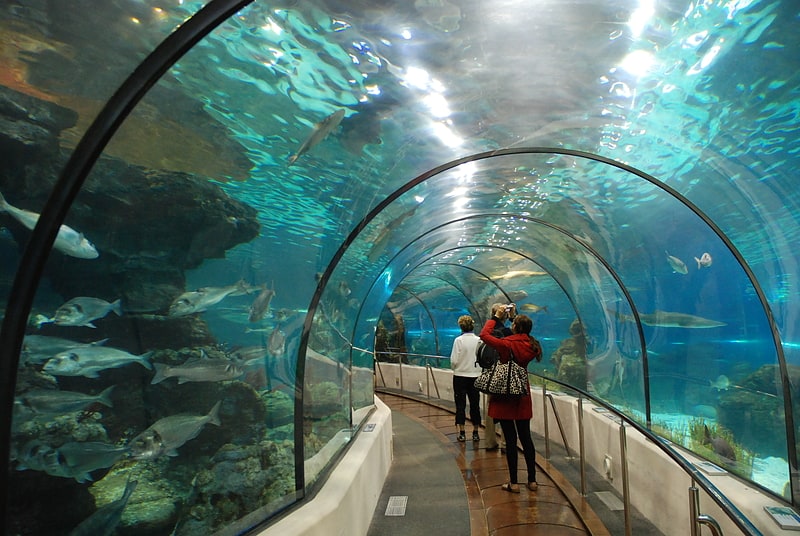
Also known as: Aquarium de Barcelona
Themed tanks with varied marine habitats. Aquarium Barcelona is an aquarium located in Port Vell, a harbor in Barcelona, Catalonia, Spain.
The 35 aquariums at the facility are home to 11,000 animals representing 451 species. The aquarium contains a total of 5,000,000 l (1,300,000 US gal). This includes an ocean tank for sharks, rays and other large fish, which is 36 m (118 ft) in diameter, 5 m (16 ft) deep, contains 3,700,000 l (980,000 US gal) of water and has an 80-meter (260 ft) underwater tunnel. The Aquarium of Barcelona is part of the Aspro Parks.
The aquarium is a member of the Iberian Association of Zoos and Aquaria (AIZA).[16]
Address: del Port Vell, s/n, 08039 Barcelona (Ciutat Vella)
Barcelona Cathedral
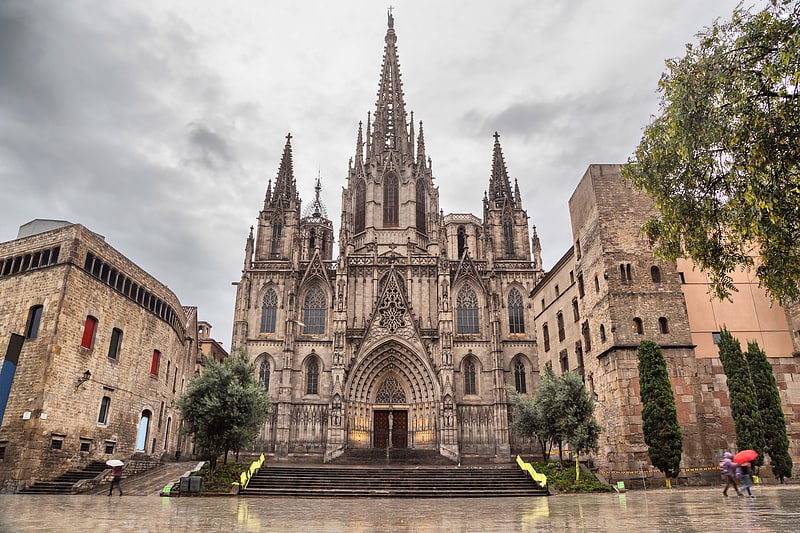
Also known as: Catedral de la Santa Cruz y Santa Eulalia de Barcelona
Landmark 13th-century place of worship. The Cathedral of the Holy Cross and Saint Eulalia, also known as Barcelona Cathedral, is the Gothic cathedral and seat of the Archbishop of Barcelona, Catalonia, Spain. The cathedral was constructed from the thirteenth to fifteenth centuries, with the principal work done in the fourteenth century. The cloister, which encloses the Well of the Geese, was completed in 1448. In the late nineteenth century, the neo-Gothic façade was constructed over the nondescript exterior that was common to Catalan churches. The roof is notable for its gargoyles, featuring a wide range of animals, both domestic and mythical.
Its form is pseudo-basilica, vaulted over five aisles, the outer two divided into chapels. The transept is truncated. The east end is a chevet of nine radiating chapels connected by an ambulatory. The high altar is raised, allowing a clear view into the crypt.
The cathedral is dedicated to Eulalia of Barcelona, co-patron saint of Barcelona, a young virgin who, according to Catholic tradition, suffered martyrdom during Roman times in the city. One story says that she was exposed naked in the public square and a miraculous snowfall in mid-spring covered her nudity. The enraged Romans put her into a barrel with knives stuck into it and rolled it down a street (according to tradition, the one now called Baixada de Santa Eulàlia). The body of Saint Eulalia is entombed in the cathedral's crypt.
The choir stalls retain the coats-of-arms of the knights of the Order of the Golden Fleece. In his first trip into Spain, Charles, the future Holy Roman Emperor, selected Barcelona as the site of a chapter of his Order. The king had arrived for his investiture as Count of Barcelona, and the city, as a Mediterranean port, offered the closest communication with other far-flung Habsburg dominions, while the large proportions of the cathedral would accommodate required grand ceremonies. In 1518 the Order's herald, Thomas Isaac, and its treasurer, Jean Micault, were commissioned to prepare the sanctuary for the first sitting of the chapter in 1519. Juan de Borgonya executed the painted decoration of the sanctuary.
"The church was named after Barcelona's patron saint Eulalia; its official name - Catedral de la Santa Creu i Santa Eulalia - is Catalan for "Cathedral of the Holy Cross and Saint Eulalia". The commonly used name La Seu refers to the status of the church as the seat of the diocese."
The side Chapel of the Holy Sacrament and of the Holy Christ of Lepanto contains a cross said to date from the time of the Battle of Lepanto (1571).
In addition to Saints Eulàlia and Olegarius, the cathedral contains the tombs of Saint Raymond of Penyafort, Count Ramon Berenguer I and his third wife Almodis de la Marche, and bishops Berenguer de Palou II, Salvador Casañas y Pagés, and Arnau de Gurb, who is buried in the Chapel of Santa Llúcia, which he had constructed.
The cathedral has a secluded Gothic cloister where 13 white geese are kept, the number explained by the assertion that Eulalia was 13 when she was martyred.
A program of cleaning and restoration of the cathedral was carried out from 1968–72.[17]
Address: Calle del Obispo, 5, 08002 Barcelona (Ciutat Vella)
Barcelona Museum of Contemporary Art
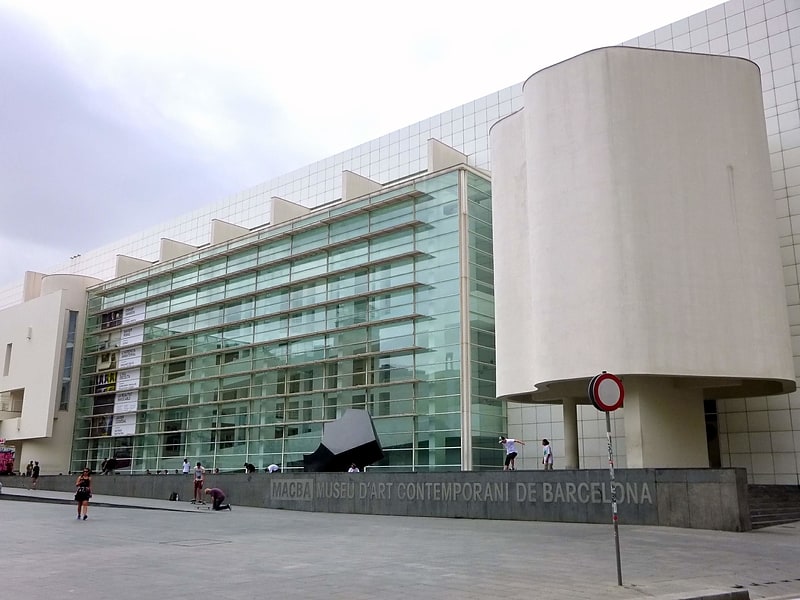
Also known as: Museo de Arte Contemporáneo de Barcelona
Modern art in sleek, glass-fronted venue. The Barcelona Museum of Contemporary Art is a contemporary art museum situated in the Plaça dels Àngels, in El Raval, Ciutat Vella, Barcelona, Catalonia, Spain. The museum opened to the public on November 28, 1995. Previous directors include Daniel Giralt-Miracle, Miquel Molins Nubiola, Manuel J. Borja-Villel, Bartomeu Marí, and Ferran Barenblit, while the current director is Elvira Dyangani Ose.[18]
Address: Plaça dels Àngels, 1, 08001 Barcelona (Ciutat Vella)
Magic Fountain of Montjuïc

Also known as: Fuente Mágica de Montjuic
Fountain in Barcelona, Spain. The Magic Fountain of Montjuïc is a fountain located at the head of Avinguda Maria Cristina in the Montjuïc neighborhood of Barcelona, Catalonia, Spain. The fountain is situated below the Palau Nacional on the Montjuïc mountain and near the Plaça d'Espanya and Poble Espanyol de Barcelona. The fountain, like most of the surrounding developments, was constructed for the 1929 Barcelona International Exposition.
The fountain sprays 700 gallons of water a second through 3620 jets to create its effect. The highest water spout is 170 feet.[19]
Address: Plaça de Carles Buïgas, 1, 08038 Barcelona (Sants-Montjuïg)
Palau de la Generalitat de Catalunya
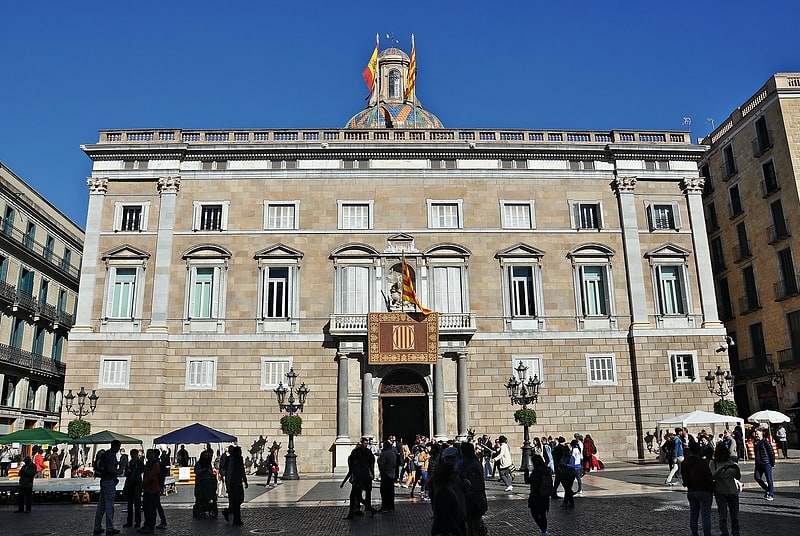
Also known as: Palacio de la Generalidad de Cataluña
Medieval building and seat of government. The Palau de la Generalitat de Catalunya is a historic palace in Barcelona, Catalonia, Spain. It houses the offices of the Presidency of the Generalitat de Catalunya. It is one of the few buildings of medieval origin in Europe that still functions as a seat of government and houses the institution that originally built it.
The palace is located in the district of Ciutat Vella in Barcelona. It is bounded by the Carrer del Bisbe, Carrer de Sant Sever and Carrer de Sant Honorat. Its principal façade gives onto the Plaça de Sant Jaume, across from the City Hall of Barcelona.
The original building was purchased in 1400 by then-president Alfons de Tous. It was located on the Carrer de Sant Honorat, in the former Jewish Quarter, or Call. The first extension (in the year 1416) faced the street and was carried out by Bishop Marc Safont, who also built the chapel of St. George, in 1434.
In 1596, Pere Blai designed the current principal façade on the Plaça de Sant Jaume, in the Renaissance style. This is the first grand façade of this architectural style in Catalonia. Thereafter, several other houses were purchased and integrated into the palace.[20]
Address: Plaça de Sant Jaume, 4, 08002 Barcelona (Ciutat Vella)
La Rambla
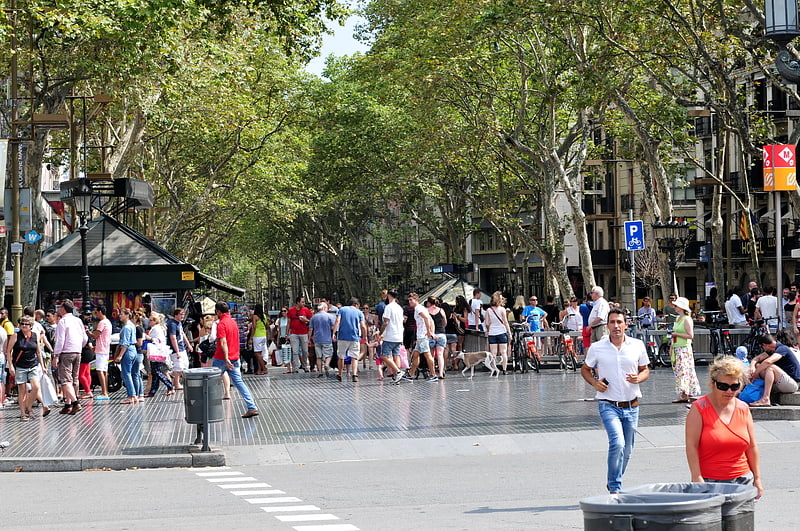
Cultural hub for shopping and sights. La Rambla is a street in central Barcelona. A tree-lined pedestrian street, it stretches for 1.2 km connecting the Plaça de Catalunya in its center with the Christopher Columbus Monument at Port Vell. La Rambla forms the boundary between the neighbourhoods of the Barri Gòtic to the east and the El Raval to the west.
La Rambla can be crowded, especially during the height of the tourist season. Its popularity with tourists has affected the character of the street, which has shifted in composition to pavement cafes and souvenir kiosks. It has also suffered from the attention of pickpockets.
The Spanish poet Federico García Lorca once said that La Rambla was "the only street in the world which I wish would never end."[21]
Address: La Rambla, Barcelona (Ciutat Vella)
FC Barcelona Museum
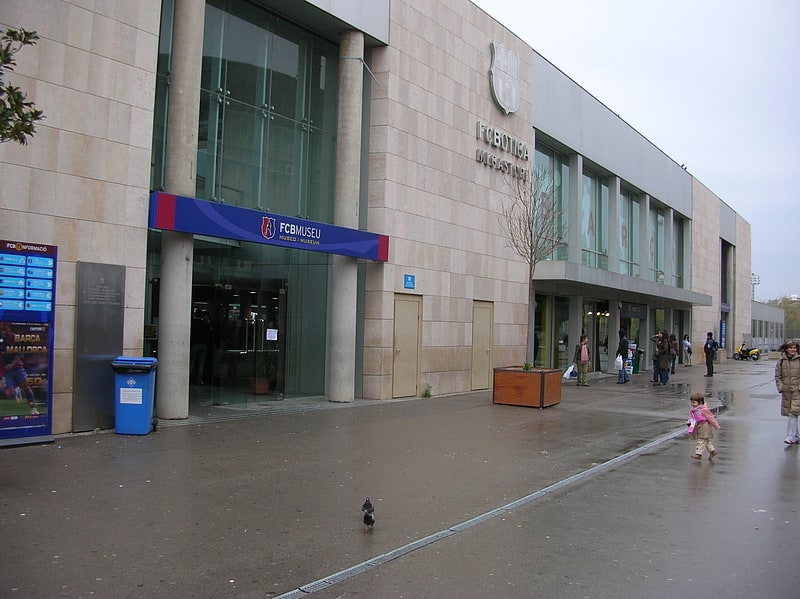
Also known as: Museo del Fútbol Club Barcelona
Museum of Barcelona's football history. The FC Barcelona museum was inaugurated on 24 September 1984 under the presidency of Josep Lluís Nuñez. In 2000, the museum was renamed President Nuñez museum under the presidency of his successor, Joan Gaspart. On 15 June 2010, the museum was reopened after a long restructuring.
The restructuring saw the museum split into three separate sections with a 3D cinema, audiovisual touch-screen, and information on the history of FC Barcelona. Since then the museum can only be visited by booking the package Camp Nou Experience, which includes the entrance to the museum and a tour of the stadium. The first section includes a collection of photos, documents and trophies detailing the club's history on an interactive glass wall, allowing visitors to touch the screens and see information wall. The glass wall, equipped with laser technology, allows the exhibition of video, images and music through user-feedback. The second section is a private art collection on permanent display at the museum which exhibits works by local artists such as Dalí, Miró and Tàpies. In the third section, the Futbolart Collection displays football memorabilia from the club including a trophy-room with every trophy, or a replica thereof, that the club has won.
One of the items at display in the Futbolart Collection is the boots with which Ronald Koeman scored the winning goal in the 1992 European Cup Final, which he did in the 111th minute against Sampdoria, 21 minutes into extra time, securing Barcelona's first European trophy.
The museum occupies 3,500 square meters and attracts 1.2 million visitors a year, ranking it second to the Museu Picasso, which attracts 1.3 million visitors, as the most visited museum in the city of Barcelona.[22]
Address: C. d'Aristides Maillol, s/n, 08028 Barcelona (Les Corts)
Casa Vicens
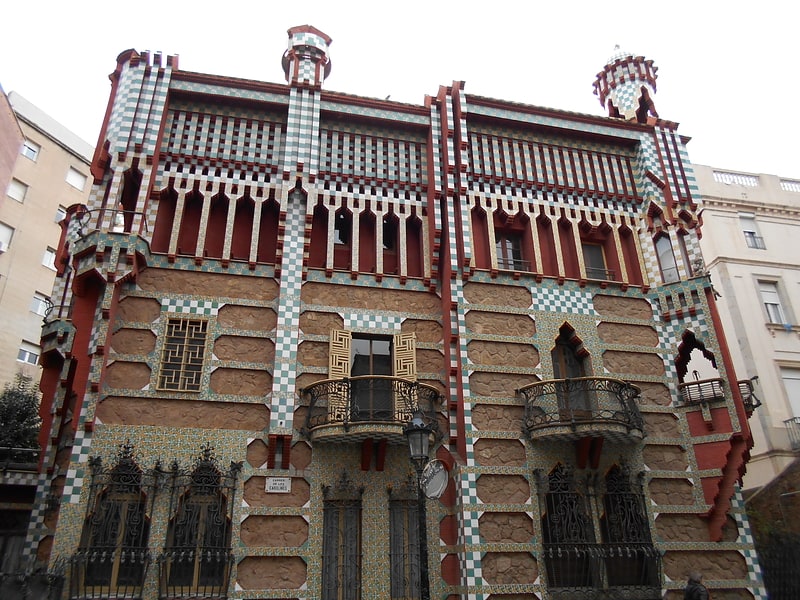
19th-century family home by Antoni Gaudi. Casa Vicens is a modernist building situated in the Gràcia neighbourhood of Barcelona. It is the work of architect Antoni Gaudí and is considered to be his first major project. It was built between 1883 and 1885, although Gaudí drew up the initial plans between 1878 and 1880. The work belongs to the orientalist style, similar to Neo-Mudéjar architecture, although interpreted in Gaudí’s own personal way, with a uniqueness that only he knew how to add to his projects. In this work, and for the first time, Gaudí outlined some of his constructive resources that would become regular features throughout the emergence of Modernism. The work was widely discussed when it was built and caused a great sensation among the general public at the time. When the building was constructed, Gràcia was still an independent urban nucleus of Barcelona; it had its own council and was classified as a town, though nowadays it is a district of the city.
The original project had a large garden area, in addition to the house, but over time the land was subdivided and sold for the construction of residential buildings. Nowadays, the property has been reduced to the house and a small surrounding area. To take advantage of the space, Gaudí designed three facades, with the house attached by a dividing wall to an adjoining convent. In 1925 an extension of the house was planned, a commission that was offered to Gaudí, which he declined. Instead, he passed it to one of his protégés, Joan Baptista Serra, who built an extension following Gaudí’s original style, with the inclusion of a new facade, resulting in the building being fully detached.
The work belongs to Gaudí’s orientalist period (1883-1888), an era in which the architect made a series of works with a distinctly oriental flavour, inspired by the art of the Near and Far East (India, Persia, Japan), as well as Hispanic Islamic art, such as Mudéjar and Nasrid. During this period, Gaudí used an abundance of ceramic tiling to decorate his work, as well as Moorish arches, columns of exposed brick and temple-shaped or dome-shaped finishes.
The building was declared a Historic-Artistic Monument in 1969, with registration number 52-MH-EN; an Asset of Cultural Interest in 1993, with reference number RI-51-0003823; and a World Heritage Site in 2005, with reference number 320bis.[23]
Address: Carrer de les Carolines, 20, 08012 Barcelona (Gràcia)
Temple Expiatori del Sagrat Cor

Also known as: Templo Expiatorio del Sagrado Corazón
Roman Catholic church and minor basilica. The Temple Expiatori del Sagrat Cor is a Roman Catholic church and minor basilica located on the summit of Mount Tibidabo in Barcelona, Catalonia, Spain. The building is the work of the Spanish architect Enric Sagnier and was completed by his son Josep Maria Sagnier i Vidal. The construction of the church, dedicated to the Sacred Heart of Jesus, lasted from 1902 to 1961.[24]
Address: Cumbre del Tibidabo, 08035 Barcelona (Sarrià-Sant Gervasi)
Montjuïc Castle
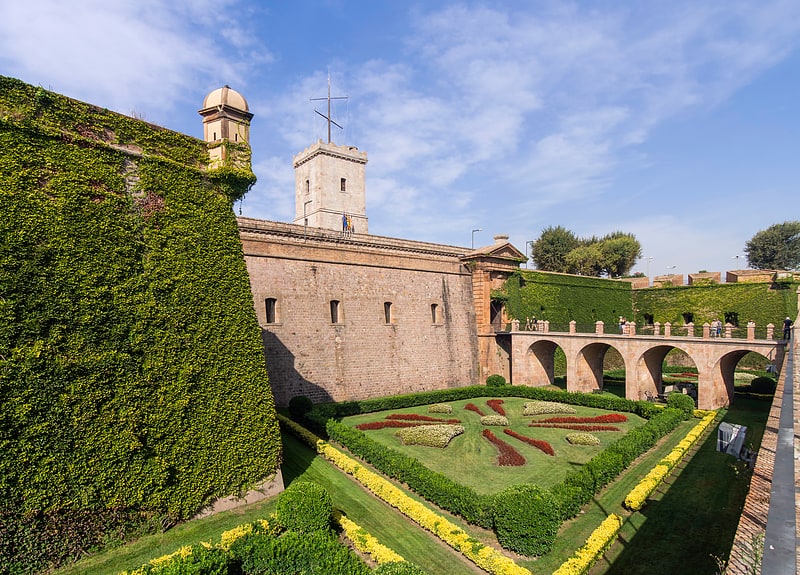
Also known as: Castillo de Montjuic
Castle in Barcelona, Spain. Montjuïc Castle is an old military fortress, with roots dating back from 1640, built on top of Montjuïc hill in Barcelona, Catalonia, Spain. It currently serves as a Barcelona municipal facility.[25]
Address: Ctra. de Montjuïc, 66, 08038 Barcelona (Sants-Montjuïg)
Torre Glòries
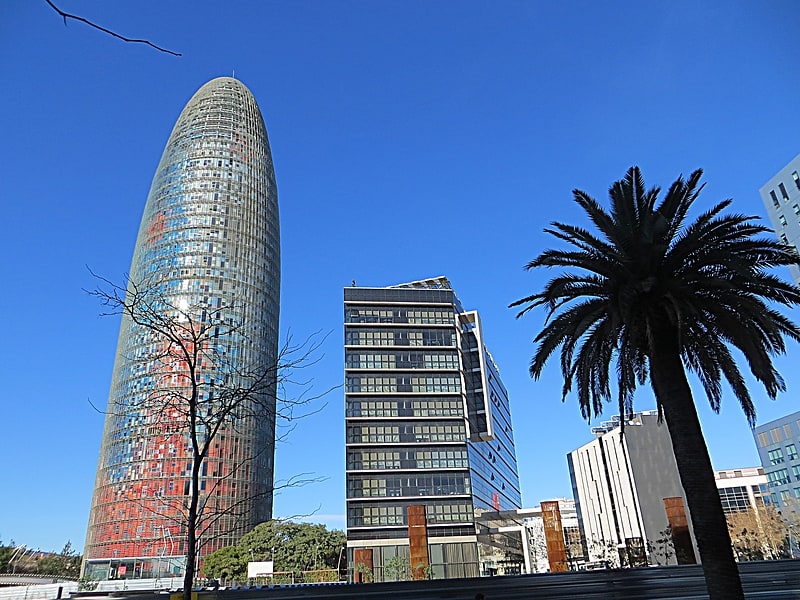
Landmark skyscraper shaped like a geyser. The Torre Glòries, formerly known as Torre Agbar, is a 38-story skyscraper located between Avenida Diagonal and Calle Badajoz, near Plaza de les Glòries Catalanes, which marks the gateway to the new technological district of Barcelona, Catalonia, Spain. It was designed by France architect Jean Nouvel in association with the Spanish firm b720 Fermín Vázquez Arquitectos and built by Dragados. The Torre Glòries is located in the Poblenou neighbourhood of Barcelona and it was originally named after its owners, the Agbar Group, a holding company whose interests include the Barcelona water company Aigües de Barcelona.
The tower is 144.44 m high with a diameter of 39 m. It has a total of 50,693 m2 (545,650 sq ft), of which 30,000 m2 (320,000 sq ft) are offices, 3,210 m2 (34,600 sq ft) technical facilities, 8,132 m2 (87,530 sq ft) services, including an auditorium, and 9,132 m2 (98,300 sq ft) parking space. It cost €130 million to build.
It opened in June 2005 and was officially opened by King Juan Carlos I on 16 September 2005. It is one in a collection of high-tech architecture examples in Barcelona.
The building was owned by the multinational group Agbar, which has its corporate headquarters in the building and which takes up most of the floors, leasing the remainder. The Agbar Tower was acquired in March 2010 for 165 million euros, after reaching an agreement with its former owner, the investment group Azurelau. Azurelau had previously bought the property in mid-2007. The purchase price was not disclosed.
By 2017 it was purchased by Merlin Properties real estate group and it was renamed as Torre Glòries after the name of the adjacent square.[26]
Address: Avinguda Diagonal, 211, 08018 Barcelona (Sant Marti)
Parc del Laberint d'Horta
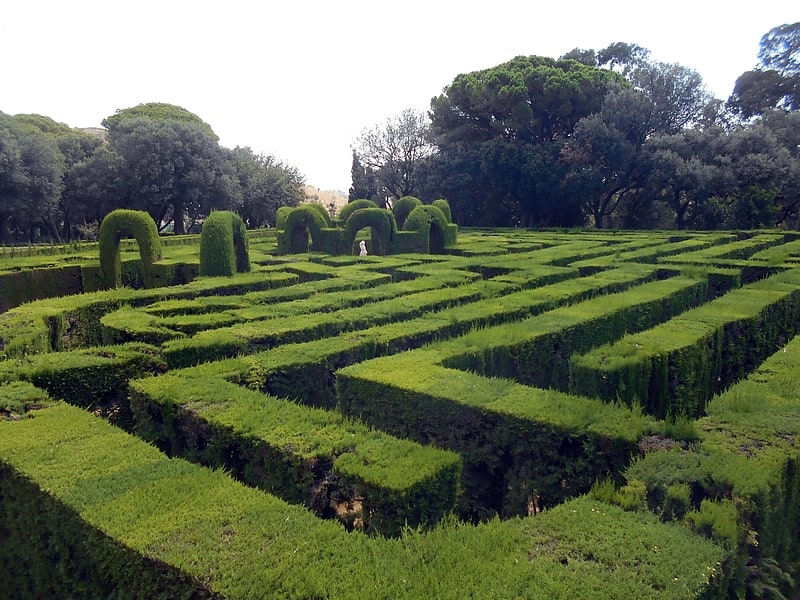
Also known as: Parque del Laberinto de Horta
18th-century park with a maze and pavilion. The Parc del Laberint d'Horta is a historical garden in the Horta-Guinardó district in Barcelona and the oldest of its kind in the city. Located on the former estate of the Desvalls family, next to the Collserola ridge, the park comprises an 18th-century neoclassical garden and a 19th-century romantic garden. On the lower terrace is the hedge maze that gives the park its name.[27]
Address: Pg. Castanyers, 1, 08035 Barcelona (Horta-Guinardó)
Fundació Joan Miró
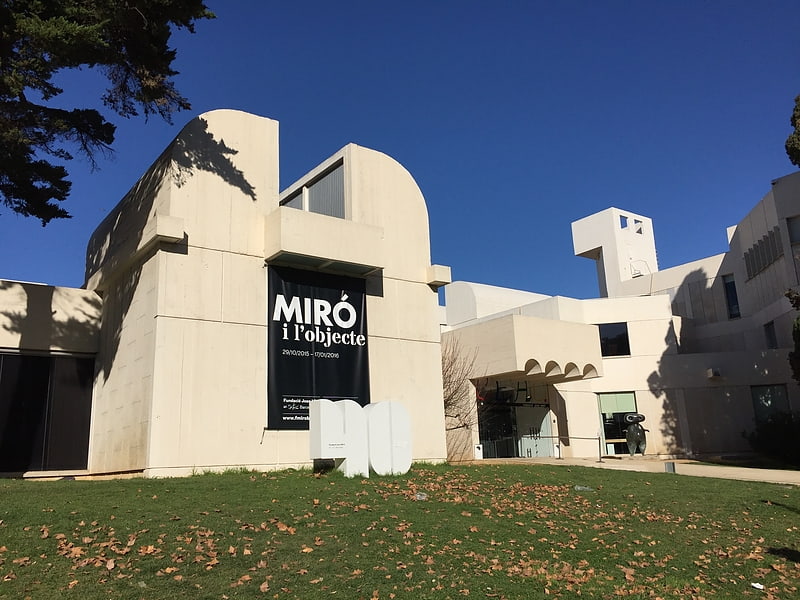
Also known as: Fundación Joan Miró
Hilltop modern art museum honoring Miro. The Fundació Joan Miró is a museum of modern art honoring Joan Miró located on the hill called Montjuïc in Barcelona, Catalonia.[28]
Address: Parc de Montjuïc, s/n, 08038 Barcelona (Sants-Montjuïg)
Santa Maria del Mar
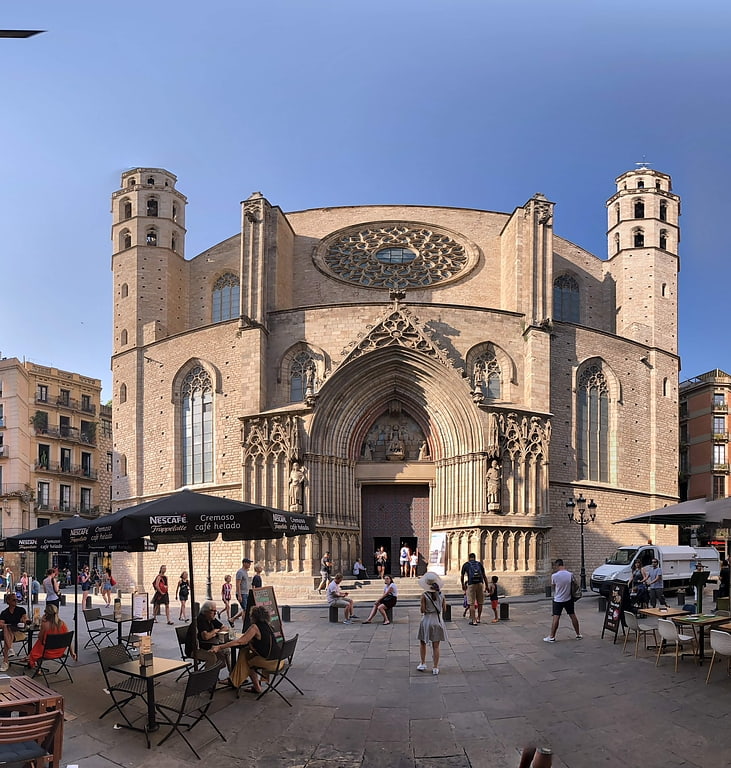
Also known as: Basílica de Santa María del Mar
Elegant 14th-century church with 3 naves. Santa Maria del Mar is a church in the Ribera district of Barcelona, Spain, built between 1329 and 1383 at the height of Principality of Catalonia's maritime and mercantile preeminence. It is an outstanding example of Catalan Gothic, with a purity and unity of style that is very unusual in large medieval buildings.[29]
Address: Plaça de Santa Maria, 4, 08003 Barcelona (Ciutat Vella)
Arc de Triomf
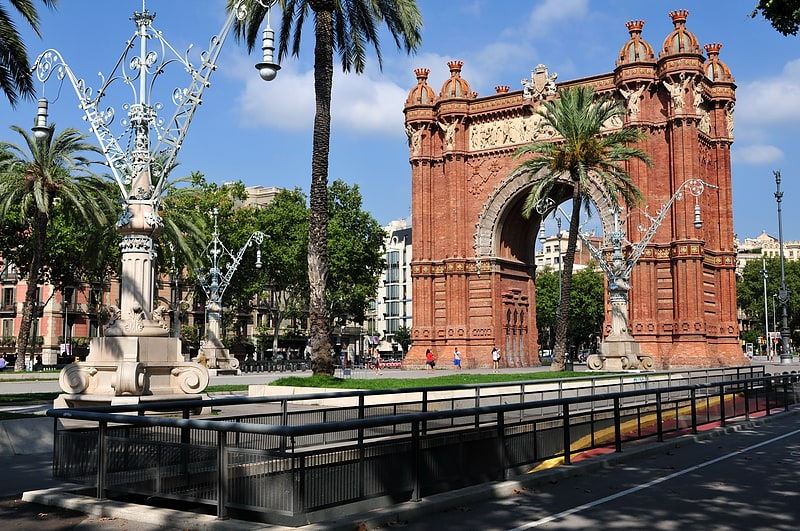
Also known as: Arco de Triunfo de Barcelona
Gateway built for an 1888 exhibition. The Arc de Triomf is a triumphal arch in the city of Barcelona in Catalonia, Spain. It was built by architect Josep Vilaseca i Casanovas as the main access gate for the 1888 Barcelona World Fair. The arch crosses over the wide central promenade of the Passeig de Lluís Companys, leading to the Ciutadella Park that now occupies the site of the world fair. It is located at the northern end of the promenade, facing the Passeig de Sant Joan.[30]
Address: Passeig Lluis Companys, 08003 Barcelona (Ciutat Vella)
Museum of the History of Catalonia
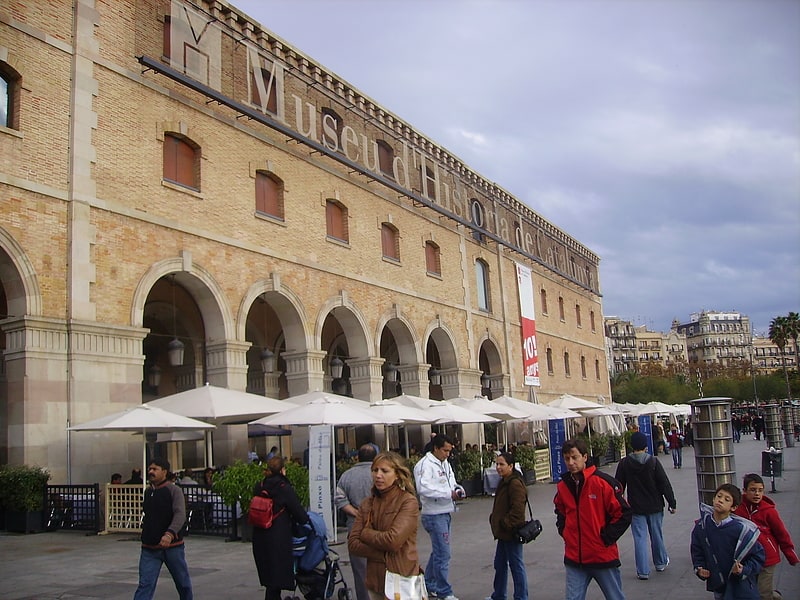
The Museum of the History of Catalonia is a history museum in Barcelona that promotes the awareness and knowledge of the history of Catalonia and its culture. The museum is located in Barcelona's Palau de Mar, the former General Stores, the sole building of Barcelona's old industrial port still standing.[31]
Address: Placa Pau Vila, 3, 08039 Barcelona (Ciutat Vella)
Poble Espanyol
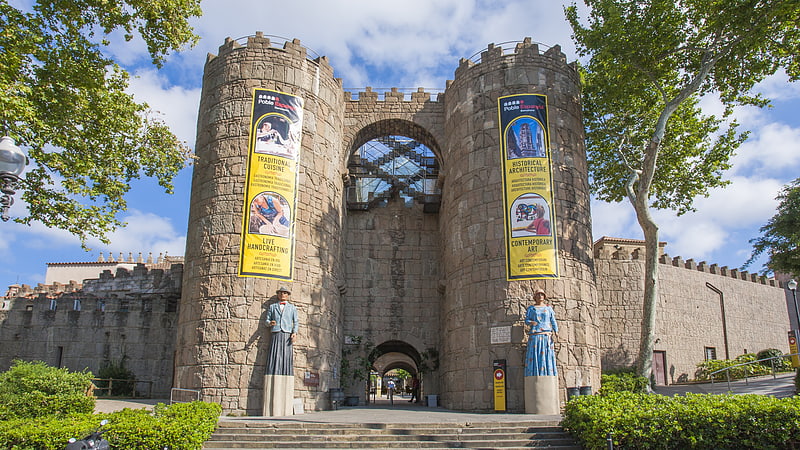
Also known as: Pueblo Español de Barcelona
Spanish regional architecture museum. The Poble Espanyol is an open-air architectural museum in Barcelona, Catalonia, Spain, approximately 400 metres away from the Fountains of Montjuïc. Built for the 1929 Barcelona International Exposition, the museum consists of 117 full-scale buildings replicated from different places in the Iberian Peninsula, joined together forming a small town recreating urban atmospheres of disparate places in Spain. It also contains a theater, restaurants, artisan workshops and a museum of contemporary art.[32]
Address: Av. Francesc Ferrer i Guàrdia, 13, 08038 Barcelona (Sants-Montjuïg)
Museu de Ciències Naturals de Barcelona

Museum in Barcelona, Spain. The Museum of Natural Sciences of Barcelona is a natural history museum located in Barcelona, Spain.[33]
Liceu
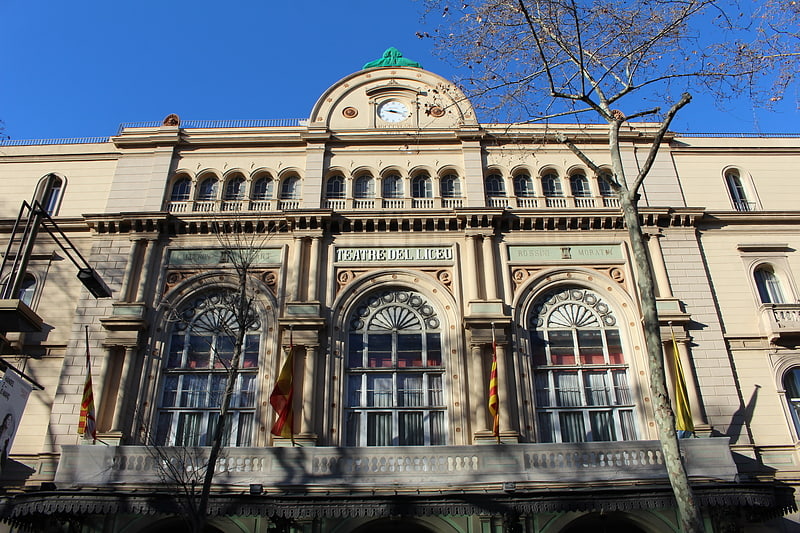
Also known as: Gran Teatro del Liceo
Ornate 19th-century opera house. The Gran Teatre del Liceu, or Liceu in Catalan, is an opera house on La Rambla in Barcelona, Catalonia, Spain. The Liceu opened on 4 April 1847. The adjacent Liceu metro station is named after the theatre.[34]
Address: Barcelona, La Rambla, 51–59
Rambla de Catalunya
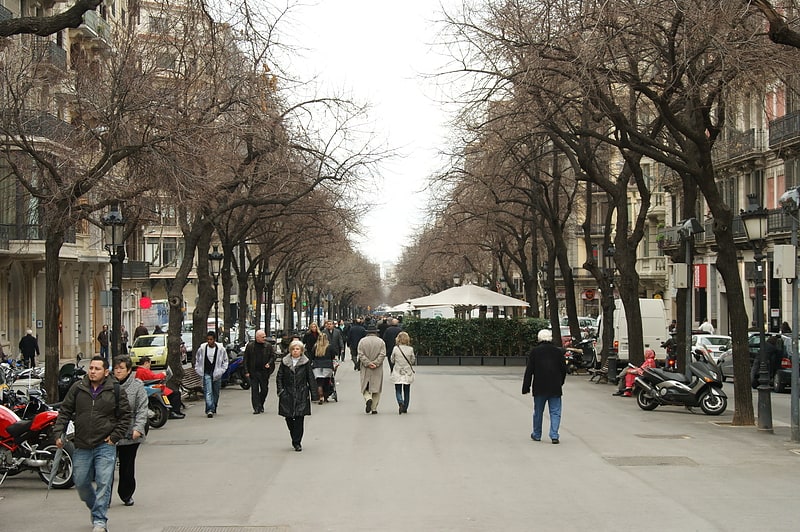
Also known as: Rambla de Cataluña
Street in Barcelona, Spain. Rambla de Catalunya is a major street in the Eixample district of central Barcelona. It is one of the city's trendiest streets, with many international fashion shops, and is lined with lime trees.
The street stretches from Plaça de Catalunya to Avinguda Diagonal, a distance of some 1.3 kilometres (0.81 mi). It runs parallel to, and between, the Passeig de Gràcia and Carrer de Balmes. It can be seen as an extension into the Eixample of the famous La Rambla.[35]
Address: Rambla de Catalunya, Barcelona (Eixample)